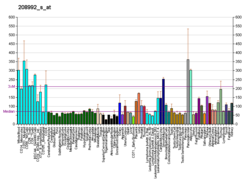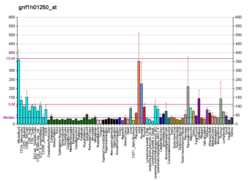シグナル伝達兼転写活性化因子3
シグナル伝達兼転写活性化因子3(signal transducer and activator of transcription 3、STAT3)は、ヒトではSTAT3遺伝子にコードされる転写因子である[5]。STATタンパク質ファミリーのメンバーである。
機能
[編集]STAT3はSTATタンパク質ファミリーのメンバーである。STAT3は、受容体に結合したヤヌスキナーゼ(JAK)によってサイトカインや成長因子に応答してリン酸化され、ホモ二量体またはヘテロ二量体を形成し、細胞核へ移行して転写アクチベーターとして作用する。具体的には、STAT3はインターフェロン、上皮成長因子(EGF)、IL-5、IL-6などのリガンドに応答してチロシン705番残基がリン酸化されて活性化される。さらに、STAT3の活性化はMAPKによるセリン727番残基のリン酸化[6]やc-src非受容体型チロシンキナーゼによるリン酸化によっても行われる可能性がある[7][8]。STAT3は細胞刺激に応答してさまざまな遺伝子の発現を媒介し、そのため細胞成長やアポトーシスなど多くの細胞過程に重要な役割を果たす[9]。
STAT3欠損マウス胚は、原腸形成が開始される胎生7日を越えて発生することができない[10]。こうした発生の初期段階において、STAT3の活性化は胚性幹細胞(ESC)の自己複製に必要なようである。実際に、マウスのESCの培養の際に未分化状態を維持するために添加されるLIFは、他の方法によってSTAT3が活性化されている場合には省くことができる[11]。
STAT3は、さまざまな自己免疫疾患への関与が示唆されている、Th17ヘルパーT細胞の分化に必要不可欠である[12]。ウイルス感染時、T細胞でSTAT3を欠くマウスは濾胞性ヘルパーT細胞(Tfh細胞)の形成能力に欠陥がみられ、抗体を基盤とした免疫を維持することができない[13]。
STAT3はがんの転移に関与する因子であるE-セレクチンのアップレギュレーションを引き起こす[14]。
臨床的意義
[編集]STAT3遺伝子の機能喪失変異は高IgE症候群を引き起こす。この疾患は、反復性感染症、骨や歯の発生の異常と関係している[15]。
STAT3遺伝子の機能獲得変異は、甲状腺疾患、糖尿病、腸炎、血球数の低下など、多器官で早発性自己免疫疾患を引き起こすことが報告されている[16]。STAT3の恒常的活性化はヒトのさまざまながんと関係しており、一般的に予後の悪さを示唆する[17][18][19][20]。増殖効果とともに抗アポトーシス効果を示す[17]。一方で、STATのがん抑制における役割も報告されている[21][22][23]。がん細胞でのSTAT3の活性の増大は炎症性遺伝子の発現を制御するタンパク質複合体の機能を変化させ、セクレトームや細胞の表現型、腫瘍内での活性、転移能に大きな変化をもたらす[24]。
相互作用
[編集]STAT3は次に挙げる因子と相互作用することが示されている。
ニクロサミドはSTAT3シグナル伝達経路を阻害するようである[54]。
出典
[編集]- ^ a b c GRCh38: Ensembl release 89: ENSG00000168610 - Ensembl, May 2017
- ^ a b c GRCm38: Ensembl release 89: ENSMUSG00000004040 - Ensembl, May 2017
- ^ Human PubMed Reference:
- ^ Mouse PubMed Reference:
- ^ “Molecular cloning of APRF, a novel IFN-stimulated gene factor 3 p91-related transcription factor involved in the gp130-mediated signaling pathway”. Cell 77 (1): 63–71. (April 1994). doi:10.1016/0092-8674(94)90235-6. PMID 7512451.
- ^ “p42/p44 MAPK-mediated Stat3Ser727 phosphorylation is required for progestin-induced full activation of Stat3 and breast cancer growth”. Endocrine-Related Cancer 20 (2): 197–212. (April 2013). doi:10.1530/ERC-12-0194. PMID 23329648.
- ^ “Role of STATs as downstream signal transducers in Src family kinase-mediated tumorigenesis”. Oncogene 23 (48): 8017–23. (October 2004). doi:10.1038/sj.onc.1208159. PMID 15489919.
- ^ “Structure, function, and regulation of STAT proteins”. Molecular BioSystems 2 (11): 536–50. (November 2006). doi:10.1039/B606246F. PMID 17216035..
- ^ “Central role of the threonine residue within the p+1 loop of receptor tyrosine kinase in STAT3 constitutive phosphorylation in metastatic cancer cells”. Molecular and Cellular Biology 24 (21): 9390–400. (November 2004). doi:10.1128/MCB.24.21.9390-9400.2004. PMC 522220. PMID 15485908. 15485908.
- ^ “Targeted disruption of the mouse Stat3 gene leads to early embryonic lethality”. Proceedings of the National Academy of Sciences of the United States of America 94 (8): 3801–4. (April 1997). Bibcode: 1997PNAS...94.3801T. doi:10.1073/pnas.94.8.3801. PMC 20521. PMID 9108058.
- ^ “STAT3 activation is sufficient to maintain an undifferentiated state of mouse embryonic stem cells”. The EMBO Journal 18 (15): 4261–9. (August 1999). doi:10.1093/emboj/18.15.4261. PMC 1171502. PMID 10428964.
- ^ “STAT3 regulates cytokine-mediated generation of inflammatory helper T cells”. The Journal of Biological Chemistry 282 (13): 9358–63. (March 2007). doi:10.1074/jbc.C600321200. PMID 17277312.
- ^ “T-cell STAT3 is required for the maintenance of humoral immunity to LCMV”. European Journal of Immunology 45 (2): 418–27. (February 2015). doi:10.1002/eji.201445060. PMC 4383653. PMID 25393615.
- ^ Coppo, Roberto; Orso, Francesca; Virga, Federico; Dalmasso, Alberto; Baruffaldi, Desirée; Nie, Lei; Clapero, Fabiana; Dettori, Daniela et al. (2021-07-10). “ESDN inhibits melanoma progression by blocking E-selectin expression in endothelial cells via STAT3”. Cancer Letters 510: 13–23. doi:10.1016/j.canlet.2021.04.005. ISSN 1872-7980. PMID 33862151.
- ^ “STAT3 signaling and the hyper-IgE syndrome”. The New England Journal of Medicine 357 (16): 1655–8. (October 2007). doi:10.1056/NEJMe078197. PMID 17881746.
- ^ “Early-onset lymphoproliferation and autoimmunity caused by germline STAT3 gain-of-function mutations”. Blood 125 (4): 591–9. (January 2015). doi:10.1182/blood-2014-09-602763. PMC 4304103. PMID 25359994.
- ^ a b “Signal transducers and activators of transcription (STATs): Novel targets of chemopreventive and chemotherapeutic drugs”. Current Cancer Drug Targets 6 (2): 107–21. (March 2006). doi:10.2174/156800906776056491. PMID 16529541.
- ^ “Signal transducer and activator of transcription 3 is required for the oncogenic effects of non-small-cell lung cancer-associated mutations of the epidermal growth factor receptor”. Cancer Research 66 (6): 3162–8. (March 2006). doi:10.1158/0008-5472.CAN-05-3757. PMID 16540667.
- ^ “Active Stat3 is required for survival of human squamous cell carcinoma cells in serum-free conditions”. Molecular Cancer 5 (1): 15. (April 2006). doi:10.1186/1476-4598-5-15. PMC 1502137. PMID 16603078.
- ^ “Activation of STAT3 is a marker of poor prognosis in human colorectal cancer”. Oncology Reports 15 (6): 1445–51. (June 2006). doi:10.3892/or.15.6.1445. PMID 16685378.
- ^ “Identification of a PTEN-regulated STAT3 brain tumor suppressor pathway”. Genes & Development 22 (4): 449–62. (February 2008). doi:10.1101/gad.1606508. PMC 2238667. PMID 18258752.
- ^ “Signal transducer and activator of transcription 3 (STAT3) protein suppresses adenoma-to-carcinoma transition in Apcmin/+ mice via regulation of Snail-1 (SNAI) protein stability”. The Journal of Biological Chemistry. 22 287 (22): 18182–9. (May 2012). doi:10.1074/jbc.M111.328831. PMC 3365759. PMID 22496368.
- ^ “Stat3 is a negative regulator of intestinal tumor progression in Apc(Min) mice”. Gastroenterology 138 (3): 1003–11.e1–5. (March 2010). doi:10.1053/j.gastro.2009.11.049. PMID 19962983.
- ^ Vlahopoulos, SA (August 2017). “Aberrant control of NF-κB in cancer permits transcriptional and phenotypic plasticity, to curtail dependence on host tissue: molecular mode.”. Cancer Biology & Medicine 14 (3): 254–270. doi:10.20892/j.issn.2095-3941.2017.0029. PMC 5570602. PMID 28884042.
- ^ a b “Activation of the androgen receptor N-terminal domain by interleukin-6 via MAPK and STAT3 signal transduction pathways”. The Journal of Biological Chemistry 277 (9): 7076–85. (March 2002). doi:10.1074/jbc.M108255200. PMID 11751884.
- ^ “Cross-talk between signal transducer and activator of transcription 3 and androgen receptor signaling in prostate carcinoma cells”. Biochemical and Biophysical Research Communications 283 (1): 179–87. (April 2001). doi:10.1006/bbrc.2001.4758. PMID 11322786.
- ^ “A Stat3-interacting protein (StIP1) regulates cytokine signal transduction”. Proceedings of the National Academy of Sciences of the United States of America 97 (18): 10120–5. (August 2000). Bibcode: 2000PNAS...9710120C. doi:10.1073/pnas.170192197. PMC 27739. PMID 10954736.
- ^ “Synergistic signaling in fetal brain by STAT3-Smad1 complex bridged by p300”. Science 284 (5413): 479–82. (April 1999). doi:10.1126/science.284.5413.479. PMID 10205054.
- ^ a b “Central role of the threonine residue within the p+1 loop of receptor tyrosine kinase in STAT3 constitutive phosphorylation in metastatic cancer cells”. Molecular and Cellular Biology 24 (21): 9390–400. (November 2004). doi:10.1128/MCB.24.21.9390-9400.2004. PMC 522220. PMID 15485908.
- ^ “ErbB receptor-induced activation of stat transcription factors is mediated by Src tyrosine kinases”. The Journal of Biological Chemistry 274 (24): 17209–18. (June 1999). doi:10.1074/jbc.274.24.17209. PMID 10358079.
- ^ “STAT3 inhibits the degradation of HIF-1alpha by pVHL-mediated ubiquitination”. Experimental & Molecular Medicine 40 (5): 479–85. (October 2008). doi:10.3858/emm.2008.40.5.479. PMC 2679355. PMID 18985005.
- ^ a b “Constitutive activation of STAT transcription factors in acute myelogenous leukemia”. European Journal of Haematology 67 (2): 63–71. (August 2001). doi:10.1034/j.1600-0609.2001.t01-1-00385.x. PMID 11722592.
- ^ “Interacting regions in Stat3 and c-Jun that participate in cooperative transcriptional activation”. Molecular and Cellular Biology 19 (10): 7138–46. (October 1999). doi:10.1128/MCB.19.10.7138. PMC 84707. PMID 10490649.
- ^ “Human leptin signaling in human peripheral blood mononuclear cells: activation of the JAK-STAT pathway”. Cellular Immunology 211 (1): 30–6. (July 2001). doi:10.1006/cimm.2001.1815. PMID 11585385.
- ^ “Serine phosphorylation and maximal activation of STAT3 during CNTF signaling is mediated by the rapamycin target mTOR”. Current Biology 10 (1): 47–50. (January 2000). doi:10.1016/S0960-9822(99)00268-7. PMID 10660304.
- ^ “Interleukin-12-induced interferon-gamma production by human peripheral blood T cells is regulated by mammalian target of rapamycin (mTOR)”. The Journal of Biological Chemistry 280 (2): 1037–43. (January 2005). doi:10.1074/jbc.M405204200. PMID 15522880.
- ^ “Reciprocal inhibition between MyoD and STAT3 in the regulation of growth and differentiation of myoblasts”. The Journal of Biological Chemistry 278 (45): 44178–87. (November 2003). doi:10.1074/jbc.M304884200. PMID 12947115.
- ^ “The cell death regulator GRIM-19 is an inhibitor of signal transducer and activator of transcription 3”. Proceedings of the National Academy of Sciences of the United States of America 100 (16): 9342–7. (August 2003). Bibcode: 2003PNAS..100.9342Z. doi:10.1073/pnas.1633516100. PMC 170920. PMID 12867595.
- ^ a b “Signal transducers and activators of transcription 3 (STAT3) inhibits transcription of the inducible nitric oxide synthase gene by interacting with nuclear factor kappaB”. The Biochemical Journal 367 (Pt 1): 97–105. (October 2002). doi:10.1042/BJ20020588. PMC 1222853. PMID 12057007.
- ^ “STAT3-dependent enhanceosome assembly and disassembly: synergy with GR for full transcriptional increase of the alpha 2-macroglobulin gene”. Genes & Development 17 (20): 2564–77. (October 2003). doi:10.1101/gad.1135003. PMC 218150. PMID 14522952.
- ^ “STAT3 acts as a co-activator of glucocorticoid receptor signaling”. The Journal of Biological Chemistry 272 (49): 30607–10. (December 1997). doi:10.1074/jbc.272.49.30607. PMID 9388192.
- ^ “Functional interaction of STAT3 transcription factor with the coactivator NcoA/SRC1a”. The Journal of Biological Chemistry 277 (10): 8004–11. (March 2002). doi:10.1074/jbc.M111486200. PMID 11773079.
- ^ “Opposing effects of PML and PML/RAR alpha on STAT3 activity”. Blood 101 (9): 3668–73. (May 2003). doi:10.1182/blood-2002-08-2474. PMID 12506013.
- ^ “Regulation of STAT3 by direct binding to the Rac1 GTPase”. Science 290 (5489): 144–7. (October 2000). Bibcode: 2000Sci...290..144S. doi:10.1126/science.290.5489.144. PMID 11021801.
- ^ “Activation of signal transducer and activator of transcription 3 by oncogenic RET/PTC (rearranged in transformation/papillary thyroid carcinoma) tyrosine kinase: roles in specific gene regulation and cellular transformation”. Molecular Endocrinology 17 (6): 1155–66. (June 2003). doi:10.1210/me.2002-0401. PMID 12637586.
- ^ “MEN2A-RET-induced cellular transformation by activation of STAT3”. Oncogene 20 (38): 5350–8. (August 2001). doi:10.1038/sj.onc.1204715. PMID 11536047.
- ^ “Replication protein a 32 kDa subunit (RPA p32) binds the SH2 domain of STAT3 and regulates its transcriptional activity”. Cell Biology International 24 (7): 467–73. (2000). doi:10.1006/cbir.2000.0525. PMID 10875894.
- ^ “Involvement of tyrosine phosphatase PTP1D in the inhibition of interleukin-6-induced Stat3 signaling by alpha-thrombin”. Biochemical and Biophysical Research Communications 288 (1): 252–7. (October 2001). doi:10.1006/bbrc.2001.5759. PMID 11594781.
- ^ “Identification of both positive and negative domains within the epidermal growth factor receptor COOH-terminal region for signal transducer and activator of transcription (STAT) activation”. The Journal of Biological Chemistry 277 (34): 30716–23. (August 2002). doi:10.1074/jbc.M202823200. PMID 12070153.
- ^ “Stat3 regulates centrosome clustering in cancer cells via Stathmin/PLK1”. Nature Communications 8: 15289. (May 2017). Bibcode: 2017NatCo...815289M. doi:10.1038/ncomms15289. PMC 5424153. PMID 28474672.
- ^ “Activation and association of Stat3 with Src in v-Src-transformed cell lines”. Molecular and Cellular Biology 16 (4): 1595–603. (April 1996). doi:10.1128/MCB.16.4.1595. PMC 231145. PMID 8657134.
- ^ “Activation of Stat3 transcription factor by Herpesvirus saimiri STP-A oncoprotein”. Journal of Virology 78 (12): 6489–97. (June 2004). doi:10.1128/JVI.78.12.6489-6497.2004. PMC 416526. PMID 15163742.
- ^ “STAT3 nuclear import is independent of tyrosine phosphorylation and mediated by importin-alpha3”. Proceedings of the National Academy of Sciences of the United States of America 102 (23): 8150–5. (June 2005). Bibcode: 2005PNAS..102.8150L. doi:10.1073/pnas.0501643102. PMC 1149424. PMID 15919823.
- ^ “Identification of Niclosamide as a New Small-Molecule Inhibitor of the STAT3 Signaling Pathway”. ACS Medicinal Chemistry Letters 1 (9): 454–9. (2010). doi:10.1021/ml100146z. PMC 4007964. PMID 24900231.
関連文献
[編集]- STATs as mediators of cytokine-induced responses. Advances in Immunology. 71. (1999). pp. 145–62. doi:10.1016/S0065-2776(08)60401-0. ISBN 978-0-12-022471-5. PMID 9917912
- “Signaling through the JAK/STAT pathway, recent advances and future challenges”. Gene 285 (1–2): 1–24. (February 2002). doi:10.1016/S0378-1119(02)00398-0. PMID 12039028.
- “Nef: "necessary and enforcing factor" in HIV infection”. Current HIV Research 3 (1): 87–94. (January 2005). doi:10.2174/1570162052773013. PMID 15638726.
- “New and old functions of STAT3: a pivotal target for individualized treatment of cancer”. Cell Cycle 4 (9): 1131–3. (September 2005). doi:10.4161/cc.4.9.1985. PMID 16082218.
- “STAT3 as a therapeutic target in head and neck cancer”. Expert Opinion on Biological Therapy 6 (3): 231–41. (March 2006). doi:10.1517/14712598.6.3.231. PMID 16503733.
- “Targeting signal-transducer-and-activator-of-transcription-3 for prevention and therapy of cancer: modern target but ancient solution”. Annals of the New York Academy of Sciences 1091 (1): 151–69. (December 2006). Bibcode: 2006NYASA1091..151A. doi:10.1196/annals.1378.063. PMID 17341611.








